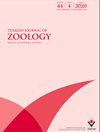土耳其黑海东部地区埃及伊蚊(L., 1762)的分子系统发育及其与高加索入侵的可能关系(双翅目:库蚊科)
IF 1.7
4区 生物学
Q2 ZOOLOGY
引用次数: 0
摘要
埃及伊蚊(L., 1762)(双翅目:库蚊科)是危害人类健康的重要害虫。它传播许多疾病,包括黄热病(YF)、登革热(DENV)和基孔肯雅热(CHIKV)。在过去的几十年里,这个物种入侵了许多国家,包括巴尔干和高加索国家。2015年在土耳其发现了已建立的种群。我们使用四种线粒体和一种基因组DNA标记研究了来自土耳其和格鲁吉亚的样本之间的遗传变异、分子系统发育和差异。利用最大似然树对每个基因区分别确定了物种的可能起源。ML分析结果表明,该基因与高加索人种有密切的亲缘关系,部分单倍型是该地区特有的。我们的研究结果表明,土耳其Ae。埃及伊蚊菌株可能是亚洲和美洲菌株的混合体。根据AMOVA,土耳其和格鲁吉亚样本之间的差异在统计学上不显著,差异值非常低。两国之间的两两差异值表明种群可能具有相同的起源,两国之间的变异值非常低。作为结论,我们的结果显示,我们的地区(土耳其和格鲁吉亚)的样本最有可能是一个新的入侵,而不是一个古老的入侵。本文章由计算机程序翻译,如有差异,请以英文原文为准。
Molecular phylogenetics of Aedes aegypti (L., 1762) (Diptera: Culicidae) in Eastern Black Sea area of Turkey and possible relations with the Caucasian invasion
: Aedes aegypti (L., 1762) (Diptera: Culicidae) is an important pest for human health. It vectors many diseases, including yellow fever (YF), dengue (DENV), and chikungunya (CHIKV). This species has invaded numerous countries including Balkan and Caucasian countries few past decades. The established populations of species were found in Turkey in 2015. We investigated the genetic variation, molecular phylogenetics, and differences between samples from Turkey and Georgia using four mitochondrial and one genomic DNA markers. The possible origin of the species was determined separately for each gene region using maximum likelihood trees. The ML analysis showed a close relation with the Caucasian samples, and some haplotypes are specific to this region. Our results suggest that Turkish Ae. aegypti strains might have been a mix of Asian and American strains. The differences between Turkish and Georgian samples were statistically insignificant and values of difference were very low according to AMOVA. Pairwise difference values between the two countries indicated that populations may have the same origin and variation value between two countries is very low. As a conclusion, our results revealed that our region (Turkey and Georgia) samples were most probably a new invasion rather than an ancient one.
求助全文
通过发布文献求助,成功后即可免费获取论文全文。
去求助
来源期刊

Turkish Journal of Zoology
ZOOLOGY-
CiteScore
2.30
自引率
10.00%
发文量
24
审稿时长
6-12 weeks
期刊介绍:
The Turkish Journal of Zoology is published electronically 6 times a year by the Scientific and Technological Research Council of Turkey (TÜBİTAK).
-Accepts English-language manuscripts in various fields of zoology including systematics, developmental biology, behaviour biology, animal models, molecular biology and molecular phylogeny, genomics, physiology (cell communication and signaling systems), biochemistry and immunohistochemistry, applied parasitology and pathology, nanobiotechnology, ecology, evolution, and paleontology of animal taxa.
-Contribution is open to researchers of all nationalities.
-Short communications are also welcome, such as reports of a preliminary nature or those including new records from specific localities or regions, and the editor reserves the right to decide that a paper be treated as a short communication.
-The papers that deal with purely checklists, new host and non-regional new locality records will not be consider for publication.
-Letters to the editor reflect the opinions of other researchers on the articles published in the journal. The editor may also invite review articles concerning recent developments in particular areas of interest.
 求助内容:
求助内容: 应助结果提醒方式:
应助结果提醒方式:


